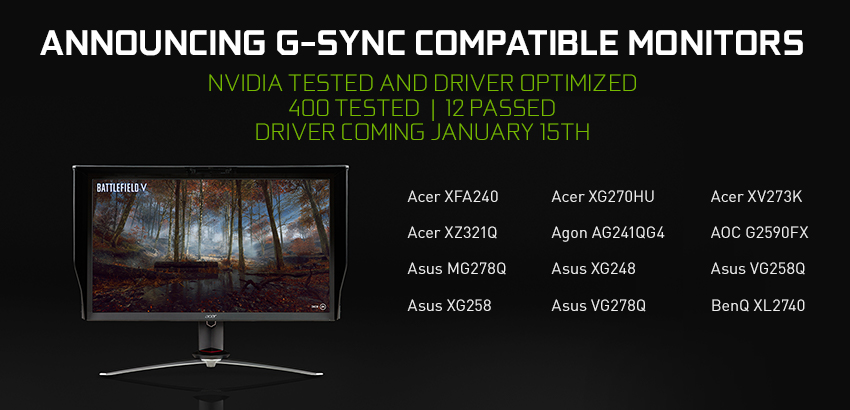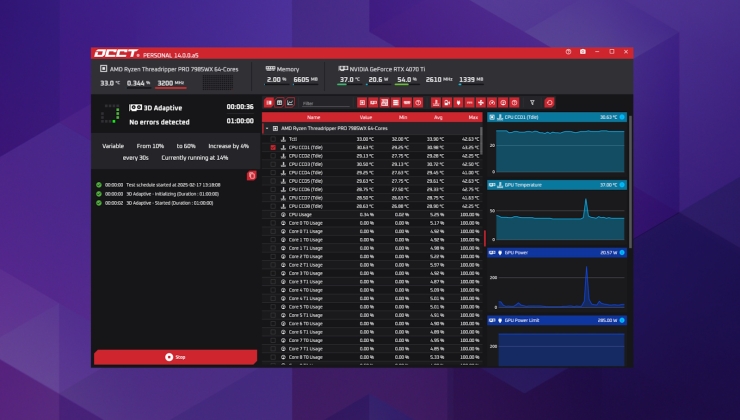As a bit of a win for everyone, NVIDIA have announced that they will be supporting VESA Adaptive Sync.
While NVIDIA have been pushing their own proprietary G-SYNC to get rid of screen tearing, AMD has been pushing the more open FreeSync. Annoying as always, since it splits the market for us consumers and makes things more difficult for us.
Announced a few hours ago, NVIDIA will be supporting some FreeSync monitors with their own special branding. They claim there's a huge difference in how well some monitors work and so they will be testing various monitors and approving them.
To start with, they will support these monitors:
However, it's not totally down to NVIDIA on what monitors will work. They will be including an option in the NVIDIA control panel for you to try yourself:
For VRR monitors yet to be validated as G-SYNC Compatible, a new NVIDIA Control Panel option will enable owners to try and switch the tech on - it may work, it may work partly, or it may not work at all.
Additionally, it seems they will only be supporting this across GeForce GTX 10-Series and GeForce RTX 20-Series graphics cards so my lowly 980ti is out of luck.
They say a new driver will be out later this month, although it's not entirely clear what the status of Linux support will be. Hopefully there won't be any issues, since as far as I can tell G-SYNC is supported on Linux already.
See more on the official NVIDIA post.
time to say goodbye to proprietary nvidia blob - i couldnt be happier.
this polaris card is the best linux driver experience i had in a long time... so freesync it will be anyways as a prefer open standards.
You have to make sure the game window covers the whole Xorg screen or else you'll get no flipping. If there's even one pixel that doesn't belong to the same application, flipping turns off (and any syncing with it). That means if you have more than one monitor and the desktop is spanning across them you're likely left with blit only. On Windows there's an "exclusive fullscreen mode" and from what I heard it turns off other displays while the game is running and active. On Linux maybe compositing would help as it's essentially a big window that draws the actual windows inside of it so it can be flipped. YMMV as always.
I also have [a very specific bug](https://devtalk.nvidia.com/default/topic/1045121/processes-inside-network-namespaces-can-t-use-flipping-and-g-sync/) related to network namespaces (I doubt many people would hit it). Quite surprisingly, Arthur Huillet found me on IRC and we had a productive chat about this issue, I hope it will be fixed one day. For now I'm using that kernel hack I did.
Other than that G-Sync works great. No tearing, perfect response time, just what games should look like. The downside is its price (and of course being NVIDIA-only tech but that's not an issue for me), my monitor is about 1.75x more expensive than a freesync analog with similar specs.
It's a bit annoying that you cannot use the secondary screens while gaming, but it is what it is and I can live with it. It would be cool, though, if the secondary screens would be automatically turned off just like in Windows.
That's really nice, I hope that sometime AMD will support G-Sync Displays aswell. I'm very happy with my Dell S2417DG, but it would suck to lose functionality if I want to switch to an AMD card.
G-Sync is proprietary and the chances of AMD being able to support it is basically NULL even if they wanted to.
Good to see the open standard is prevailing.
I.e. to clarify why it can be different. In the first case it means that Linux graphics stack implementing support for adaptive sync will work with Nvidia blob and freesync monitor. In the second case, Nvidia will still require graphics stack to support gsync to work, it just will use adaptive sync between driver and monitor to implement it.
Last edited by Shmerl on 7 Jan 2019 at 12:13 pm UTC
So that means that nvidia GPUs can work with freesync and it's only a driver whitelist of "certified" monitors that controls which ones work. How long before someone hacks the driver to bypass the whitelist and have any freesync display work with an nvidia gpu?There will be no need for such things, as mentioned in the article it will be a control panel option for anyone to turn on for any monitor and try it themselves.
Warning: Angry rant hidden in the spoiler. Feel free to ignore!
Spoiler, click me
So you shelled out for two G-Sync monitors, say dual 24" 16:9 1080p 144Hz. Side by side perhaps? What sort of games will you effectively play on that, with a border between them (regardless of "thin" bezels) and a super wide 32:9 aspect ratio? If you thought getting ultra wide 21:9 working on a single monitor was bothersome, you're in for some tough lessons from reality. Maybe you can live with the border in the middle of your games.
Or get three monitors... and now your setup is simply stupid, expensive and impractical for the vast majority of games in existence. Sure cool to run F1 racing games on that 5760x1080 setup! Let's hope your PC can handle it, and your eyes somehow evolve super wide peripheral vision!
Maybe you can flip all three on their side and have a 3240*1920 setup. Huh. Why don't you just buy a 4K monitor instead.
So perhaps the better choice is to go with a bigger monitor, maybe ultra wide 21:9 34" 3440x1440, but then you run into the problems of them being expensive as a mofo. Plus, that's not multi-monitor is it?
So then you think, hang on, did he say single X screen? Yes, thanks X! You ancient #%&§#¤ piece of computer history ¤%&#& omfg why are we still using it argghhh
Just use dual X screens! Yes, perfect! Piss right off with that happy hippie crap. Getting dual X screens working correctly is easier said then done. You're welcome to try.
So what we are left with are the last resort options.
1. Disable other monitors to get G-Sync working.
2. Have no syncing at all and get tearing/stutter/flickering etc, flip a coin.
3. Mess around with forced composition pipelines and V-Sync and just hope it's good enough.
In my personal opinion those choices range from unacceptable to barely good enough while still performing well enough.
Thanks Nvidia.
TLDR: Multi-monitor G-Sync in Linux sucks goat nads. My next card will be AMD. Period.
But for all the dual screen g-sync users... we running linux after all :D make a macro like i did =)
Running 2x Asus PG279Q and have this script as a macro for my keyboard, almost instant switch from one to two or back to one screen. Just change your resolutions and ports.
# Script to switch second monitor off or back on again
# sterky was here...
# Check if second display (DP-2) is enabled
check=$(nvidia-settings -q dpys | grep DP-2 | grep enabled)
# Switch display config
if [ -z "$check" ]; then
# If disabled - notify and enable second screen
nvidia-settings --assign CurrentMetaMode="DP-4: 2560x1440_165 +0+0, DP-2: 2560x1440_165 +2560+0"
notify-send "Dualscreen - enabled" -t 4000 -i messagebox_info
else
# If enabled - notify and disable second screen
nvidia-settings --assign CurrentMetaMode="DP-4: 2560x1440_165 +0+0"
notify-send "Dualscreen - disabled" -t 4000 -i messagebox_info
fiumm, smth happened to the formatting, so [pastebin here](https://pastebin.com/Aq1Vr2nY)
Last edited by sterky on 7 Jan 2019 at 4:12 pm UTC
Just a note on G-Sync on multiple displays: Make sure you disable the secondary screen(s) from nVidia settings (or Ubuntu display settings etc) or G-Sync will not work. Just turning the screen off doesn't work either, it has to be disabled from X server. This is in latest Ubuntu, but I believe that it applies to all the other distros as well.
It's a bit annoying that you cannot use the secondary screens while gaming, but it is what it is and I can live with it. It would be cool, though, if the secondary screens would be automatically turned off just like in Windows.
What if you have two G-Sync monitors?
Edit: helps if I read the rest of the replies.
From all I've seen, G-Sync works fine on both monitors, though I never got the 'gsync indicator' to work, it's been there long before the 4xx drivers though, contrary to the other person that said that.
Last edited by slaapliedje on 7 Jan 2019 at 5:45 pm UTC
From all I've seen, G-Sync works fine on both monitors, though I never got the 'gsync indicator' to work, it's been there long before the 4xx drivers though, contrary to the other person that said that.Are you sure it works? What does the Graphics API Indicator say? I said it appeared in 4xx because a friend of mine tested 396.54 (IIRC) and there were no indicator options at all in nvidia-settings, and that's the last 3xx branch version.
The G-Sync indicator appears in the top right corner, it's a green label that says "G-SYNC" in a thin ugly (for my taste) font, nothing fancy like in the Windows driver. If it's not there (and the option in nvidia-settings is on) you probably don't have G-Sync enabled and only have the regular V-Sync.
TLDR: Multi-monitor G-Sync in Linux sucks goat nads. My next card will be AMD. Period.Is Freesync better in this regard? I thought it's a display hardware or Xorg's limitation as it's all the same on Windows. But I haven't researched that.
Last edited by rkfg on 7 Jan 2019 at 6:21 pm UTC
That's really nice, I hope that sometime AMD will support G-Sync Displays aswell. I'm very happy with my Dell S2417DG, but it would suck to lose functionality if I want to switch to an AMD card.
AMD actually CAN'T. AMD went open standard with Freesync and did the whole thing in software. NVIDIA went the proprietary hardware route to lock users into their ecosystem and charge manufacturing partners for the Gsync license. And it should be said that NVIDIA WILL NOT be supporting Freesync because AdaptiveSync is NOT Freesync. Freesync is AMD, and Samsung and LG and other brands have been adding it to their TVs/monitors because it adds a cheap selling point to sell their TV's as monitors, which has been gaining in popularity for a decade. AdaptiveSync is a VESA standard - VESA is the same organization that sets the standards for all displays.
TLDR: Multi-monitor G-Sync in Linux sucks goat nads. My next card will be AMD. Period.Is Freesync better in this regard? I thought it's a display hardware or Xorg's limitation as it's all the same on Windows. But I haven't researched that.
I honestly don't think that it's a good time to buy a display. In fact I think that it's a TERRIBLE time, to buy either a video card or any kind of monitor. I have been using a 45in 1080pTV for eight years or so as a monitor and started jumping for joy when I discovered that 43in monitors are a thing. The problem is that they are all 4K @ 60hz and I want 120hz. And HDR. And Freesync/AdaptiveSync. Well, LG just announced their OLED TV line will be supporting all of that with the inclusion of HDMI2.1. Expect Samsung to follow up with the QLED line, and just maybe ASUS and Dell too.
I don't know what kind of display you prefer, but I noticed a long time ago that the way to make life easy was to buy the standard for whatever Hollywood had decided on with the home video format. Do that and you never have weird resolution issues. And then you go big but not too big. For most computer desks that screensize is 32in. For mine that's 40-45. Okay, once you've got your display picked out, only then do you shop for the video card to drive it.
So basically, don't worry about your display upgrade until this summer when AMD has NAVI and the new wave of tvs/monitors are out to choose from.
Last edited by jarhead_h on 7 Jan 2019 at 6:50 pm UTC
What if you have two G-Sync monitors?
Yup, I have two 4K G-Sync monitors (for work, not for gaming). You will not get any game to run on both monitors -- well, I did get one Windows game to spread up like that by accident, but still no G-Sync (I believe it was in windowed mode). So I can safely say that I've not found any way to enable G-Sync on multiple monitors. You really need to disable another monitor to get G-sync to work at all.
I've heard that Windows has the same issue -- unless you get the game to run on both displays.
And it should be said that NVIDIA WILL NOT be supporting Freesync because AdaptiveSync is NOT Freesync. Freesync is AMD, and Samsung and LG and other brands have been adding it to their TVs/monitors because it adds a cheap selling point to sell their TV's as monitors, which has been gaining in popularity for a decade. AdaptiveSync is a VESA standard - VESA is the same organization that sets the standards for all displays.
Looks like some major confusion here. Adaptive sync is a feature in DisplayPort protocol. FreeSync is a whole end to end solution that's using that DisplayPort feature.
I honestly don't think that it's a good time to buy a display. In fact I think that it's a TERRIBLE time, to buy either a video card or any kind of monitor. I have been using a 45in 1080pTV for eight years or so as a monitor and started jumping for joy when I discovered that 43in monitors are a thing. The problem is that they are all 4K @ 60hz and I want 120hz. And HDR. And Freesync/AdaptiveSync. Well, LG just announced their OLED TV line will be supporting all of that with the inclusion of HDMI2.1. Expect Samsung to follow up with the QLED line, and just maybe ASUS and Dell too.
Buying is OK, as long as you don't expect something like 4K with 144 Hz. 2.5K (2560 x 1440) IPS monitors with 144 Hz and FreeSync do look quite interesting, and it's something today's GPUs can actually handle. 4K with high refresh rate is a red herring really.
Last edited by Shmerl on 7 Jan 2019 at 10:05 pm UTC
For most computer desks that screensize isThere, fixed that for you.3224in.
More seriously, I haven’t been able to find statistics about monitor sizes.
That would be an interesting addition to the GOL's statistics :)













 How to set, change and reset your SteamOS / Steam Deck desktop sudo password
How to set, change and reset your SteamOS / Steam Deck desktop sudo password How to set up Decky Loader on Steam Deck / SteamOS for easy plugins
How to set up Decky Loader on Steam Deck / SteamOS for easy plugins
See more from me